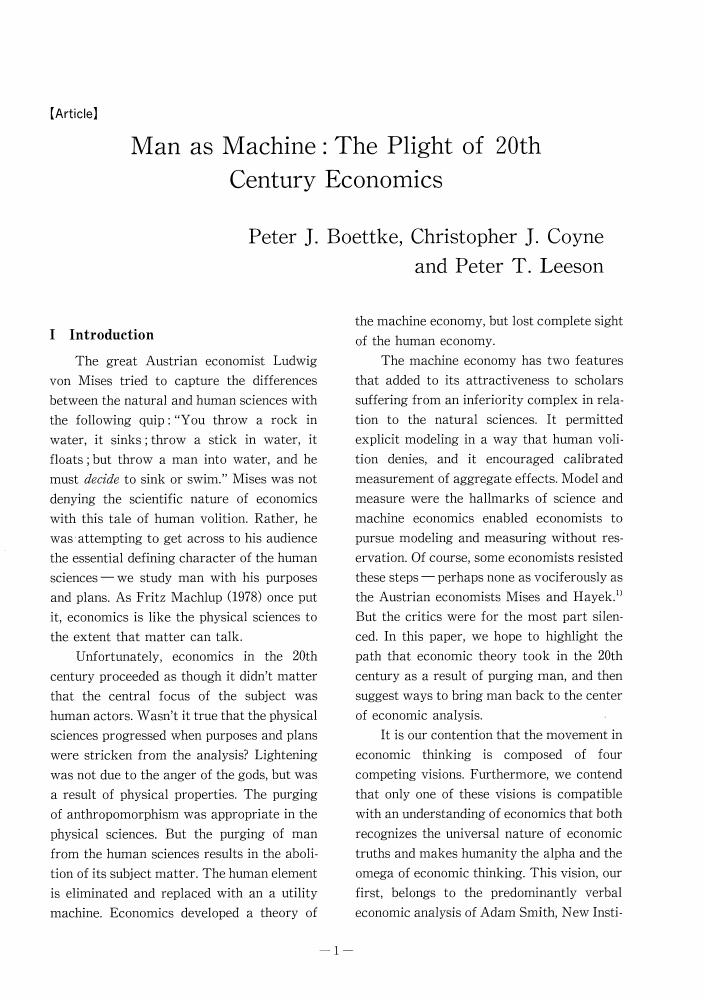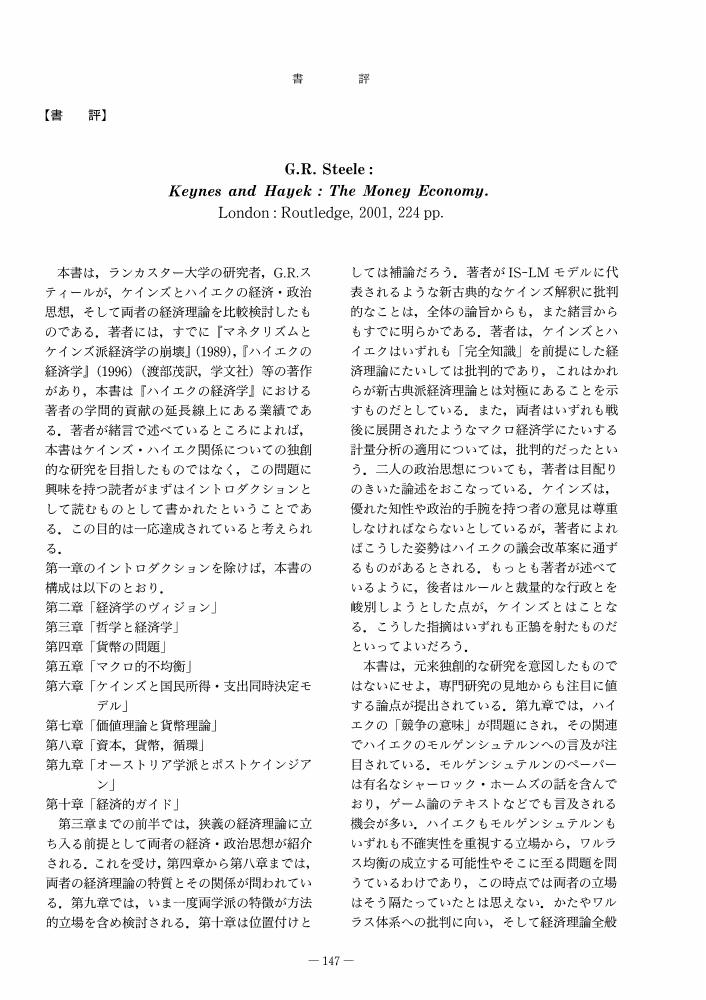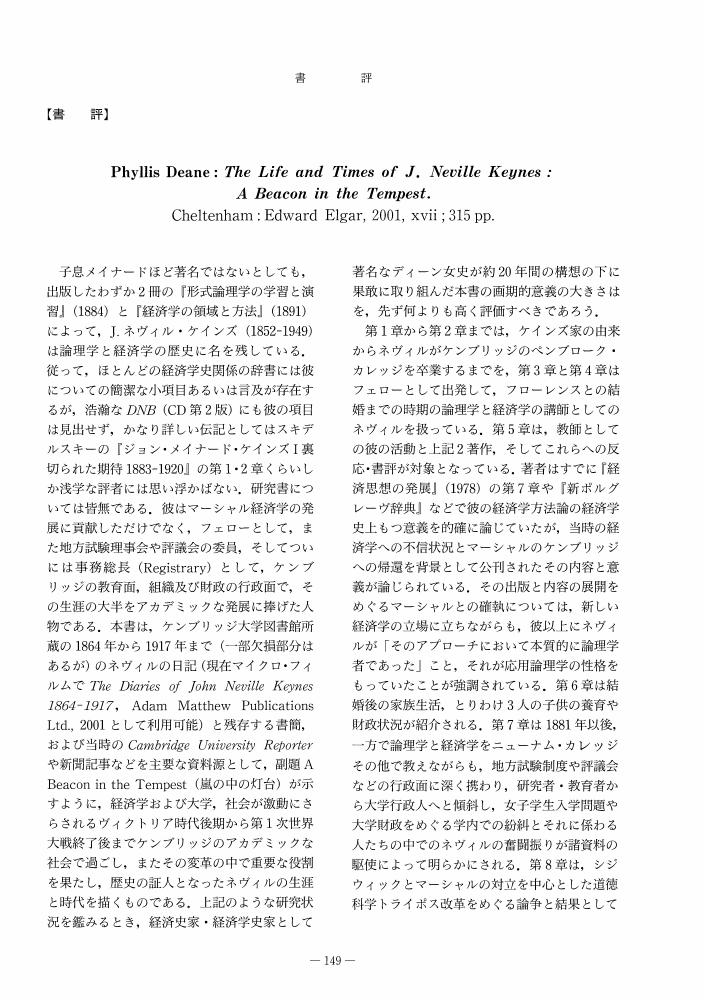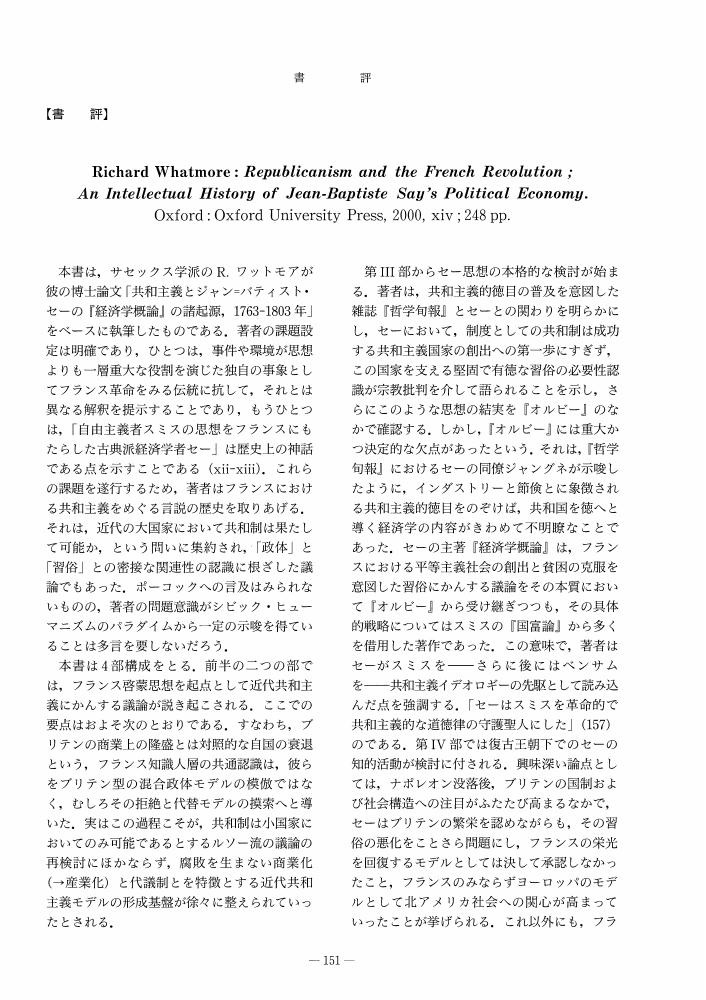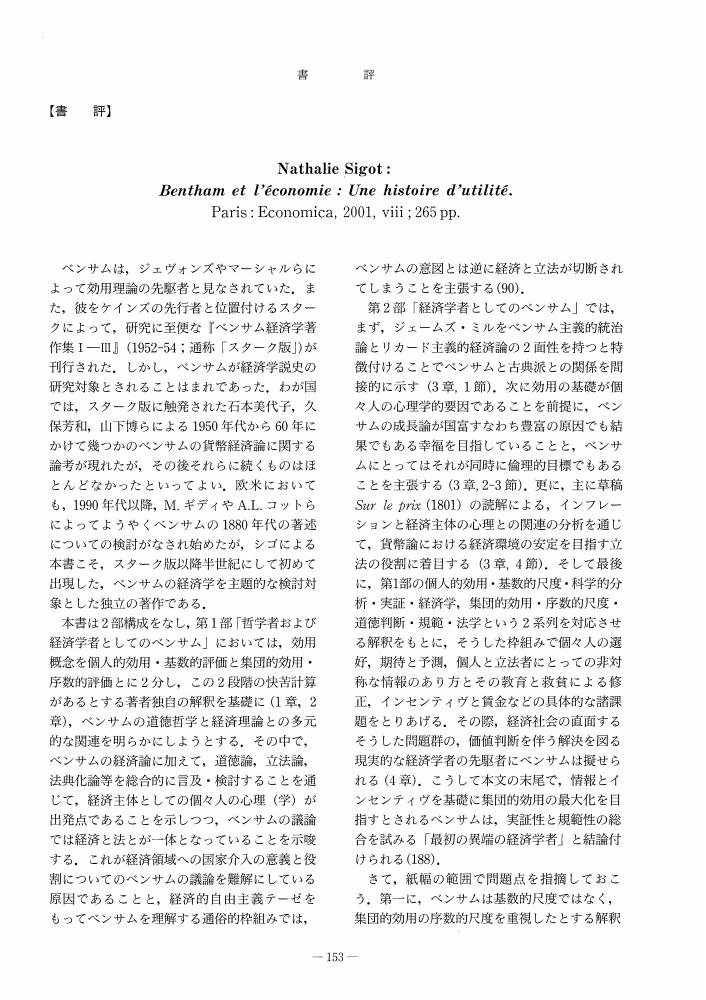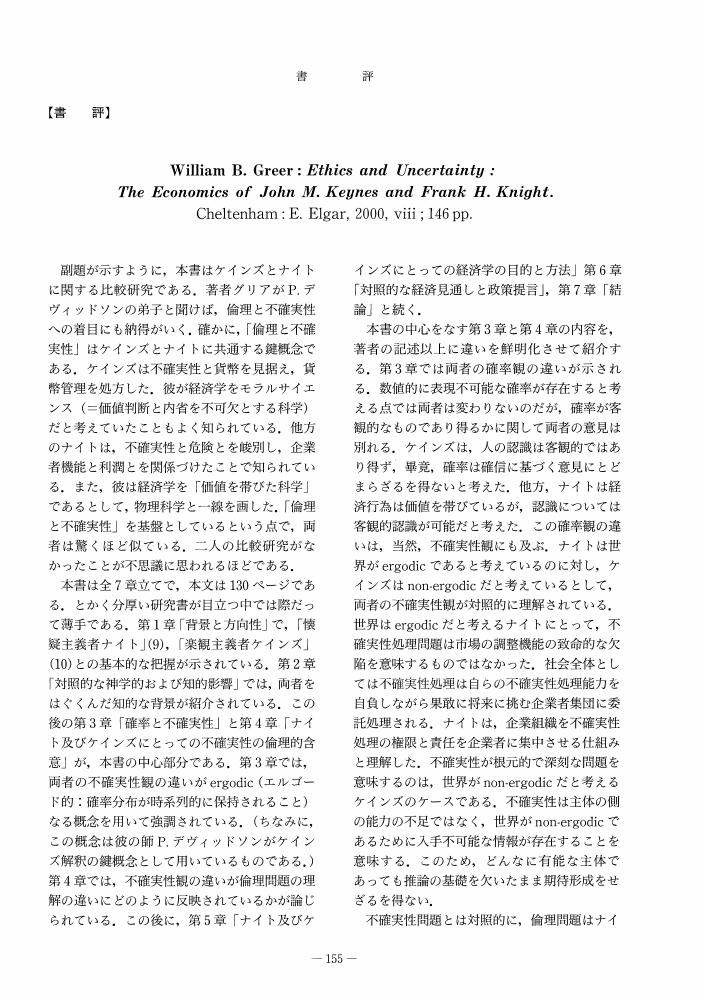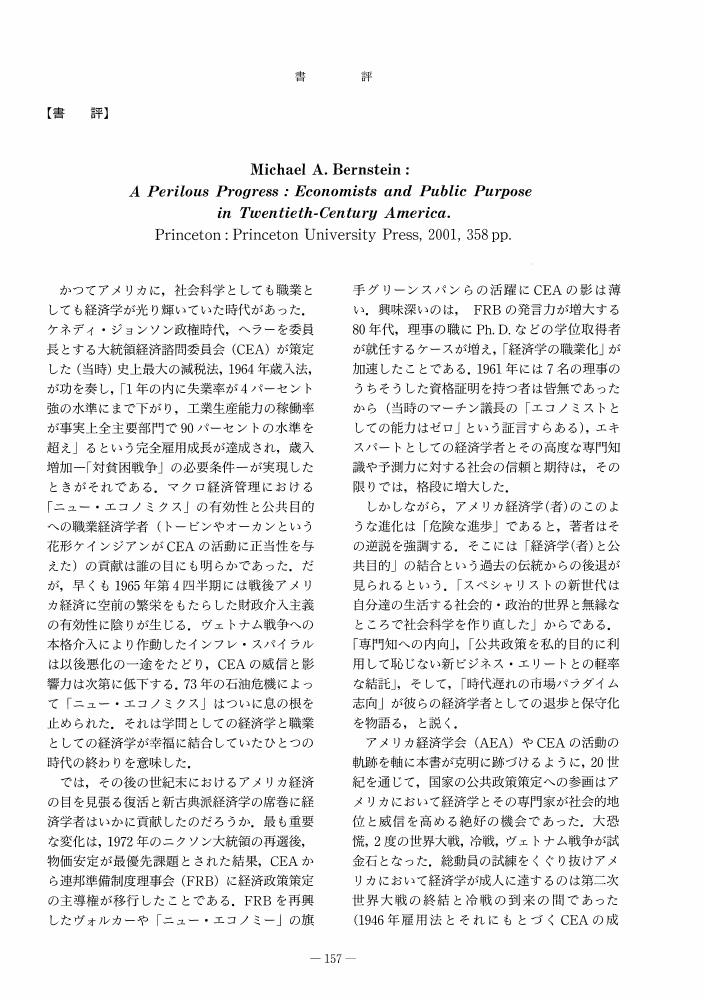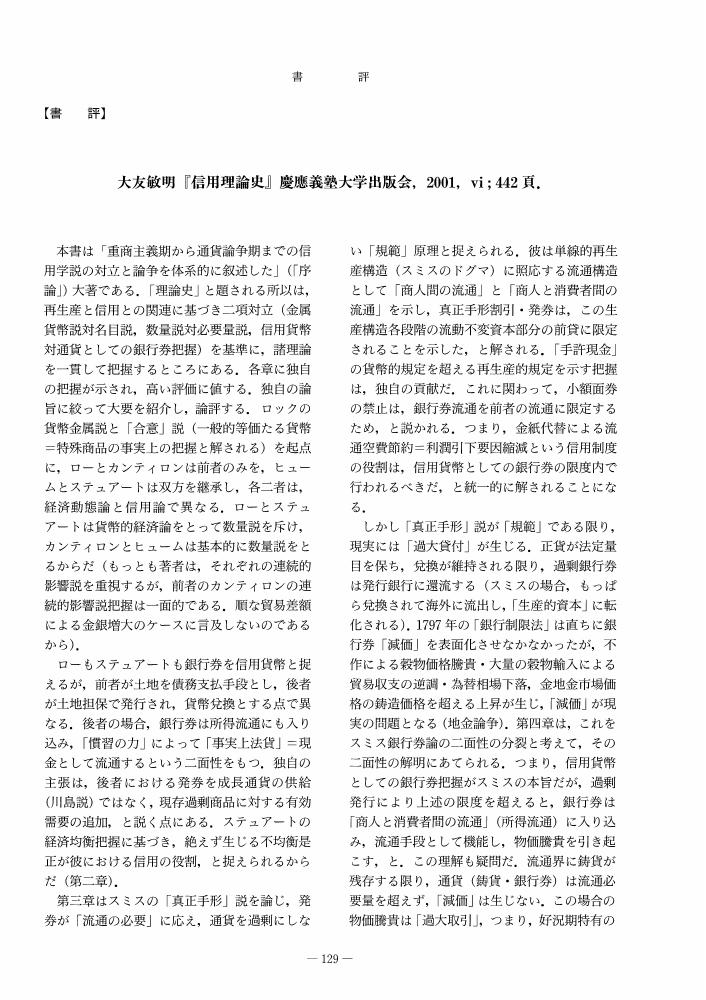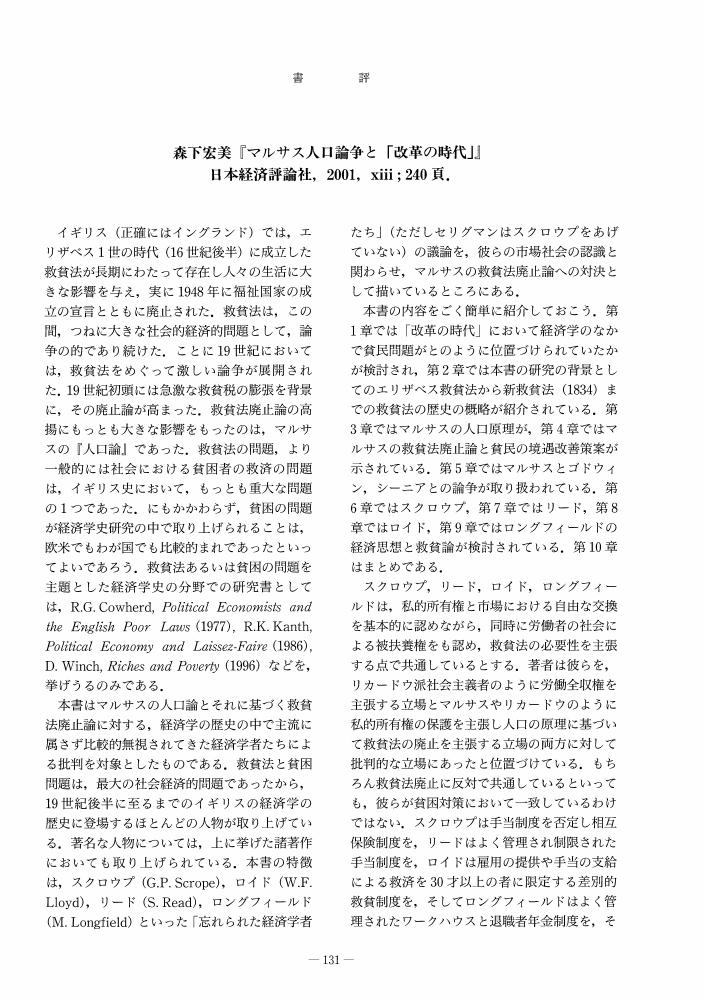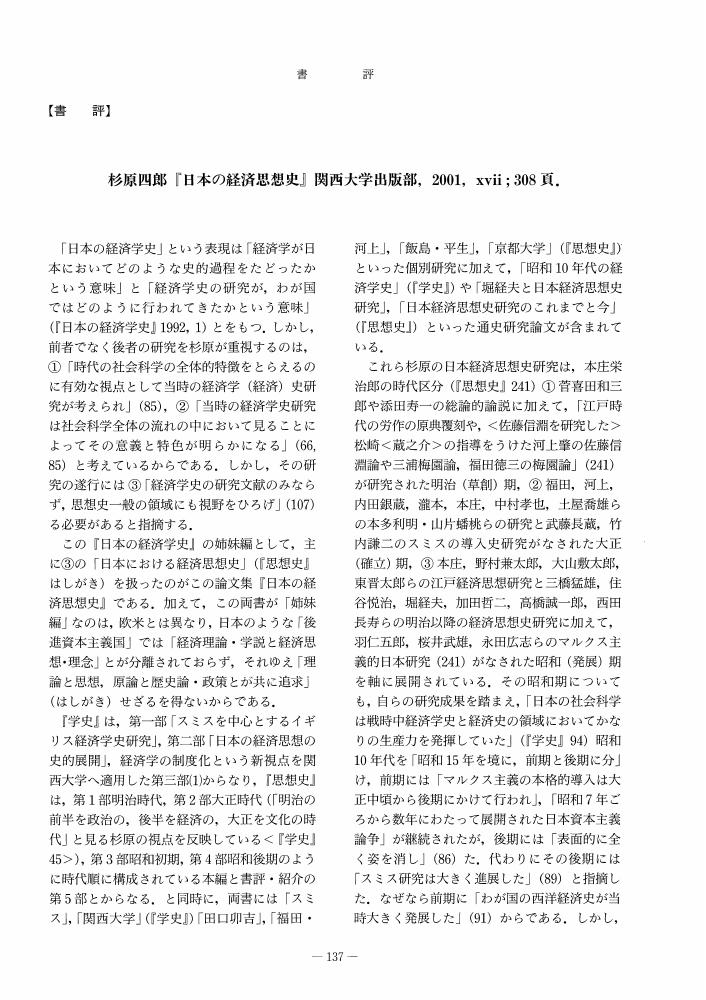- 著者
- 川俣 雅弘
- 出版者
- The Japanese Society for the History of Economic Thought
- 雑誌
- 経済学史学会年報 (ISSN:04534786)
- 巻号頁・発行日
- vol.43, no.43, pp.118-119, 2003 (Released:2010-08-05)
- 著者
- 御崎 加代子
- 出版者
- The Japanese Society for the History of Economic Thought
- 雑誌
- 経済学史学会年報 (ISSN:04534786)
- 巻号頁・発行日
- vol.42, no.42, pp.165-167, 2002 (Released:2010-08-05)
- 参考文献数
- 7
- 著者
- Peter J. Boettke Christopher J. Coyne Peter T. Leeson
- 出版者
- The Japanese Society for the History of Economic Thought
- 雑誌
- 経済学史学会年報 (ISSN:04534786)
- 巻号頁・発行日
- vol.43, no.43, pp.1-10, 2003 (Released:2010-08-05)
- 参考文献数
- 13
1 0 0 0 OA マーシャルの生産知識論
- 著者
- 藤井 賢治
- 出版者
- The Japanese Society for the History of Economic Thought
- 雑誌
- 経済学史学会年報 (ISSN:04534786)
- 巻号頁・発行日
- vol.43, no.43, pp.11-23, 2003 (Released:2010-08-05)
- 参考文献数
- 24
In this paper, we try to reinterpret Marshall's External Economies with the key con cept of “the knowledge on production methods.” In Section 2, through reexamining the criticism directed against Marshall's treatment of increasing returns, we outline the reason why we seek the possibility of “external economies at an industry level.” The consequence of the Cambridge Cost Controversy was quite legitimate as far as the adoption of the equilibrium method was premised. Marshall's representative firm cannot be supported when assessed strictly since it is a static concept that contains several dynamic forces in it. Surely, we need to adopt a dynamic method for dynamic phenomena, which Allen Young once maintained forcibly. But we differ from Young in that we consider a partial method to be useful in spite of the fact that he contended the analysis of increasing returns to be conducted in inter-industrial context.In Section 3, the function of the organization of a firm is discussed from the standpoint of “the knowledge on production methods, ” which is the type of applicable knowledge that cannot be discovered and learned from basic principles nor restored as explicit knowledge. The characteristic of the knowledge on production methods is that both improving and learning take place only gradually through a trial-and-error process. So, time and stable environments are necessary for this type of knowledge to be utilized effectively. We show that internal economies can be interpreted as the economies of specialization and integration of production knowledge at a firm level.In Section 4, we proceed to the reinterpretation of Marshall's external economies. What various firms in an industry face is the situation where the knowledge on the production methods is not in a complete form and is much diversified among them. Thus, an industry can be regarded as a place of competition over alternative production methods. Firms in an industry strive to improve their own knowledge while paying attention to the movements of other firms. Firms in the same industry can be viewed to comprise a kind of knowledge community where the knowledge on the production methods spreads and is shared. Although firms in the same industry are in a competitive relation, but are on the same vessel in another viewpoint. For, any progress in production methods carried out by one firm is a threat to others in the same industry in the short run, but contributes to the industry as a whole in the long run. The shared knowledge can contribute to unintended cooperation among firms that adopts the same production knowledge just as a commonly shared language does. Thus, standardization helps to economize coordination costs between firms in the same industry. The main contention of this paper is that Marshall's external economies can be reinterpreted as the economies available through the standardization of knowledge on production methods that takes place mainly at the industry level. Being reinterpreted in this way, Marshall's concept of external economies has a sufficient economic basis.
1 0 0 0 OA ジェイムズ・ステユアートの為替論
- 著者
- 古谷 豊
- 出版者
- The Japanese Society for the History of Economic Thought
- 雑誌
- 経済学史学会年報 (ISSN:04534786)
- 巻号頁・発行日
- vol.43, no.43, pp.24-37, 2003 (Released:2010-08-05)
- 参考文献数
- 25
In his doctrine of exchange, Steuart advanced a policy in which the exchange rate be kept at par by the state. He says that by a statesman's giving bills at par on all occasions, and being himself at the expense of transportation and insurance, in bringing home and sending off all balances, exchange would of itself come to par.Today it is widely accepted that this policy of Steuart's is only a temporary expedient. It is said that Steuart intended this policy as an emergency measure meant to avoid an evil effect of the strong sterling rate. The statesman must not intervene under normal occasions; it is allowed only when the balance of payments is in his favor, and the strong sterling rate discourages exportation.It is shown in this paper that this interpretation stems mainly from the following two factors. First, Steuart's theory is explained as a primitive equilibrium theory. Critics using this approach assert that Steuart's theory of political economy is fundamentally based on market mechanism, and that state intervention is allowed only as a temporary expedient. Second, they understood Steuart's term “high exchange” as “strong sterling rate, ” when Steuart points out that the “high exchange proves a prodigious discouragement to trade in general.”But as we see in this paper, Steuart used this term to refer to a large detachment of the exchange rate from the par. A strong sterling rate, therefore, is expressed as “a price of exchange in favour of a country, ” and a very weak sterling rate is expressed as “high exchange against a country.” According to Steuart, the problem was not the high sterling rate, but the large fluctuations of the exchange. The detachment of the exchange rate from the par, whether it be over or under the par, “produces an instability in the profits upon trade.” Thus Steuart concludes “that it is greatly for the interest of a trading state to keep exchange, at all times, as nearly at par as possible.” This exchange policy enables bills of exchange to circulate according to the true sterling value.The point I wish to emphasize in this paper is that this policy is a constituent of Steuart's monetary policy. Steuart regards bills of exchange as money, along with coins and bank notes. It holds true for bills, when Steuart states “It is of great consequence to a statesman to understand it (the doctrine of money) thoroughly; and it is of the last importance to trade and credit, that the money of a nation be kept stable and invariable.” Accordingly, Steuart enumerates this exchange policy, policy on coin, and policy on bank notes as three branches of “the whole policy of circulation.” In Steuart's theory of political economy, it is of great importance to appropriately supply circulation with stable and invariable money, and this doctrine of exchange must also be understood in this context.
1 0 0 0 OA ピグーの理想的功利主義の構造と厚生経済学
- 著者
- 山崎 聡
- 出版者
- The Japanese Society for the History of Economic Thought
- 雑誌
- 経済学史学会年報 (ISSN:04534786)
- 巻号頁・発行日
- vol.43, no.43, pp.38-51, 2003 (Released:2010-08-05)
- 参考文献数
- 38
This paper is intended as an investigation of the relation between Pigou's ethics and his welfare economics. For this purpose, I shall introduce the basic ethical knowledge that originated with J. S. Mill. This knowledge provides the structure of ethics. On the whole, ethical theory has three elements, which include the facts about moral phenomena, fundamental principles, and practical principles (criteria). As it seems that the first does not require further explanations but the latter two do, some comments shall be appended to each of the latter. First, the fundamental principle is the ultimate grounds upon which all moral judgments will be prescribed. Because the fundamental principle supplies all concrete or applied practical criteria with their foundations of justification, its attributes must be quite abstract. At the same time, the fundamental principle is the ultimate end. That justification is based on usefulness to this ultimate end. Secondly, the practical criteria are concrete applications of the fundamental principle. The latter is so abstract that we cannot in practice use it as a criterion for moral judgment. The fundamental principle is, however, the ultimate criterion as well as the ultimate ground. Therefore we must embody the fundamental principle in some particular lines. There is, however, no absolute or unique embodiment (i. e., a practical criterion), for the best criterion may differ case by case.From my interpretation of Pigou, what corresponds to the fundamental principle explained above is Pigou's theory of value: welfarism (i. e., ideal utilitarianism). Pigou says that welfare is composed of states of conscious life, each of which has intrinsic value, and that welfare is a complex whole. What should be noted is that as Pigou's theory of value (the fundamental principle) abstractly defines ultimate ends and criteria of moral judgments, it is impossible for us to make any judgments in practical concrete cases according to the fundamental principle. Therefore we must substantiate the fundamental principle for practical circumstances. Pigou, recognizing that point sufficiently, embodies welfarism in his economic theory; he considers economic welfare to be a concrete goal and defines propositions of production and distribution as means to that goal. This is one type of practical criteria. I would like to emphasize that because Pigou's original intention was to promote each individual's welfare ultimately, maximizing the total social economic welfare (a typical utilitarian prescription) is no more than one expedient for the former. Accordingly, considering the ultimate end, we can see that it is possible to choose another practical criterion instead of economic welfare. For instance, justice in distribution could be fully supported by Pigou's fundamental principle (welfarism), to which little attention has been given. Put another way, in Pigou's system, the principle of justice or right is not independent of the principle of utilitarianism; more accurately, the former is subordinate to the latter. In fact Pigou's national minimum theory, which implies distributive justice, is prescribed from his utilitarian point of view.
- 著者
- 池田 幸弘
- 出版者
- The Japanese Society for the History of Economic Thought
- 雑誌
- 経済学史学会年報 (ISSN:04534786)
- 巻号頁・発行日
- vol.42, no.42, pp.147-148, 2002 (Released:2010-08-05)
- 著者
- 上宮 正一郎
- 出版者
- The Japanese Society for the History of Economic Thought
- 雑誌
- 経済学史学会年報 (ISSN:04534786)
- 巻号頁・発行日
- vol.42, no.42, pp.149-150, 2002 (Released:2010-08-05)
- 著者
- 高橋 信勝
- 出版者
- The Japanese Society for the History of Economic Thought
- 雑誌
- 経済学史学会年報 (ISSN:04534786)
- 巻号頁・発行日
- vol.42, no.42, pp.151-152, 2002 (Released:2010-08-05)
1 0 0 0 OA Nathalie Sigot: Bentham et l'économie: Une histoire d'utilité. Paris: Economica, 2001, viii; 265pp.
- 著者
- 有江 大介
- 出版者
- The Japanese Society for the History of Economic Thought
- 雑誌
- 経済学史学会年報 (ISSN:04534786)
- 巻号頁・発行日
- vol.42, no.42, pp.153-154, 2002 (Released:2010-08-05)
- 著者
- 藤井 賢治
- 出版者
- The Japanese Society for the History of Economic Thought
- 雑誌
- 経済学史学会年報 (ISSN:04534786)
- 巻号頁・発行日
- vol.42, no.42, pp.155-156, 2002 (Released:2010-08-05)
- 著者
- 高橋 和男
- 出版者
- The Japanese Society for the History of Economic Thought
- 雑誌
- 経済学史学会年報 (ISSN:04534786)
- 巻号頁・発行日
- vol.42, no.42, pp.157-158, 2002 (Released:2010-08-05)
- 著者
- 下平 裕之
- 出版者
- The Japanese Society for the History of Economic Thought
- 雑誌
- 経済学史学会年報 (ISSN:04534786)
- 巻号頁・発行日
- vol.42, no.42, pp.159-160, 2002 (Released:2010-08-05)
- 著者
- 安藤 隆穂
- 出版者
- The Japanese Society for the History of Economic Thought
- 雑誌
- 経済学史学会年報 (ISSN:04534786)
- 巻号頁・発行日
- vol.42, no.42, pp.161-162, 2002 (Released:2010-08-05)
- 著者
- 中澤 信彦
- 出版者
- The Japanese Society for the History of Economic Thought
- 雑誌
- 経済学史学会年報 (ISSN:04534786)
- 巻号頁・発行日
- vol.42, no.42, pp.163-164, 2002 (Released:2010-08-05)
1 0 0 0 OA 大友敏明『信用理論史』慶應義塾大学出版会, 2001, vi; 442頁
- 著者
- 中村 廣治
- 出版者
- 経済学史学会
- 雑誌
- 経済学史学会年報 (ISSN:04534786)
- 巻号頁・発行日
- vol.42, no.42, pp.129-130, 2002 (Released:2010-08-05)
- 著者
- 渡会 勝義
- 出版者
- 経済学史学会
- 雑誌
- 経済学史学会年報 (ISSN:04534786)
- 巻号頁・発行日
- vol.42, no.42, pp.131-132, 2002 (Released:2010-08-05)
- 著者
- 内田 弘
- 出版者
- 経済学史学会
- 雑誌
- 経済学史学会年報 (ISSN:04534786)
- 巻号頁・発行日
- vol.42, no.42, pp.133-134, 2002 (Released:2010-08-05)
1 0 0 0 OA 小林昇『経済学史春秋』未来社, 2001, x; 209頁
- 著者
- 水田 洋
- 出版者
- 経済学史学会
- 雑誌
- 経済学史学会年報 (ISSN:04534786)
- 巻号頁・発行日
- vol.42, no.42, pp.135-136, 2002 (Released:2010-08-05)
1 0 0 0 OA 杉原四郎『日本の経済思想史』関西大学出版部, 2001, xvii; 308頁
- 著者
- 井上 琢智
- 出版者
- 経済学史学会
- 雑誌
- 経済学史学会年報 (ISSN:04534786)
- 巻号頁・発行日
- vol.42, no.42, pp.137-138, 2002 (Released:2010-08-05)


